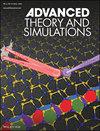DFT引导下羟基酪醇包封纳米笼的设计:氮化硼与碳富勒烯在靶向药物传递和治疗应用中的比较见解
IF 2.9
4区 工程技术
Q1 MULTIDISCIPLINARY SCIENCES
引用次数: 0
摘要
羟基酪醇(HT)是橄榄油中的一种生物活性化合物,具有治疗潜力,但受低生物利用度和不稳定性的限制。本研究探索了类似富勒烯的纳米笼(B₁₂N₁₂,B₁₆N₁₆,C₂₄,C₃₂)作为纳米载体来增强高温输送。利用DFT、QTAIM和分子对接,分析了HT与纳米笼之间的相互作用。氮化硼纳米笼,特别是B₁₂N₁₂,通过路易斯酸碱相互作用表现出最强的结合(Eads = - 25.28 kcal mol - 1),提高了稳定性(ΔG = - 11.90 kcal mol - 1)和溶解度。碳笼(C₂₄,C₃₂)表现出较弱的范德瓦尔斯相互作用(Eads =−7.42至−10.24 kcal mol−1),有利于控制释放。电子分析显示络合后HT反应性改变。QTAIM证实了(BN)n = 12,16 - HT体系中部分共价的B─O键,而碳笼依赖于色散力。紫外可见光谱显示BN - HT配合物的红移峰,表明离域增强。分子对接证明了HT -纳米笼复合物改善的治疗效果。例如,C₂₄‐HT与COVID‐19蛋白酶(EDc =−3.86 kcal mol−1)和HER2激酶(EDc =−3.99 kcal mol−1)紧密结合,增强了抗病毒和抗癌活性。同样,B₁₆- N₁₆- HT有效靶向TNF - α (EDc = - 3.70 kcal mol - 1),具有良好的抗炎作用。这些发现突出了纳米载体克服高温疗法局限性的潜力,使先进的生物医学应用成为可能。本文章由计算机程序翻译,如有差异,请以英文原文为准。
DFT‐Guided Design of Hydroxytyrosol‐Encapsulated Nanocages: Comparative Insights into Boron Nitride Versus Carbon Fullerenes for Targeted Drug Delivery and Therapeutic Applications
Hydroxytyrosol (HT), a bioactive compound in olive oil, has therapeutic potential but is limited by low bioavailability and instability. This study explores fullerene‐like nanocages (B₁₂N₁₂, B₁₆N₁₆, C₂₄, C₃₂) as nanocarriers to enhance HT delivery. Using DFT, QTAIM, and molecular docking, interactions between HT and nanocages are analyzed. Boron nitride nanocages, particularly B₁₂N₁₂, show the strongest binding (Eads = −25.28 kcal mol−1 in water) via Lewis acid‐base interactions, improving stability (ΔG = −11.90 kcal mol−1 ) and solubility. Carbon cages (C₂₄, C₃₂) exhibit weaker van der Waals interactions (Eads = −7.42 to −10.24 kcal mol−1 ), favoring controlled release. Electronic analyses reveal altered HT reactivity upon complexation. QTAIM confirms partially covalent B─O bonds in (BN)n = 12, 16 ‐HT systems, while carbon cages rely on dispersive forces. UV–vis spectra show redshifted peaks for BN‐HT complexes, indicating enhanced delocalization. Molecular docking demonstrates improved therapeutic effects of HT‐nanocage complexes. For instance, C₂₄‐HT strongly bound to COVID‐19 protease (EDc = −3.86 kcal mol−1 ) and HER2 kinase (EDc = −3.99 kcal mol−1 ), enhancing antiviral and anticancer activity. Similarly, B₁₆N₁₆‐HT effectively targets TNF‐α (EDc = −3.70 kcal mol−1 ), showing superior anti‐inflammatory effects. These findings highlight nanocarriers' potential to overcome HT's limitations, enabling advanced biomedical applications.
求助全文
通过发布文献求助,成功后即可免费获取论文全文。
去求助
来源期刊

Advanced Theory and Simulations
Multidisciplinary-Multidisciplinary
CiteScore
5.50
自引率
3.00%
发文量
221
期刊介绍:
Advanced Theory and Simulations is an interdisciplinary, international, English-language journal that publishes high-quality scientific results focusing on the development and application of theoretical methods, modeling and simulation approaches in all natural science and medicine areas, including:
materials, chemistry, condensed matter physics
engineering, energy
life science, biology, medicine
atmospheric/environmental science, climate science
planetary science, astronomy, cosmology
method development, numerical methods, statistics
 求助内容:
求助内容: 应助结果提醒方式:
应助结果提醒方式:


